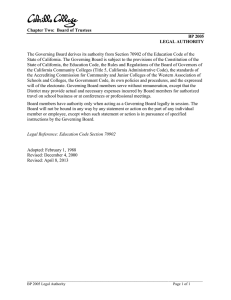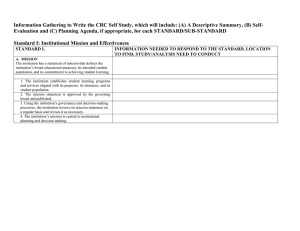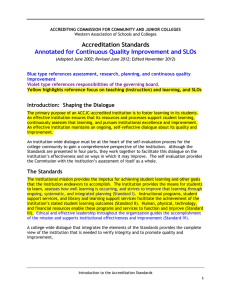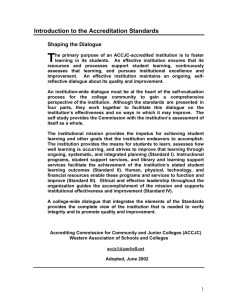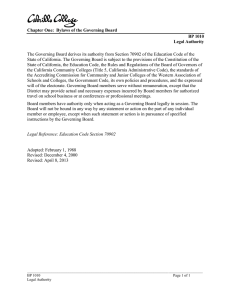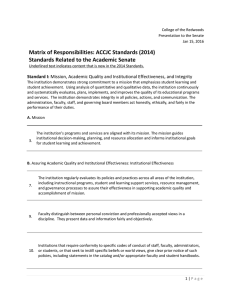ACCJC Standards (in MS Word format)
advertisement
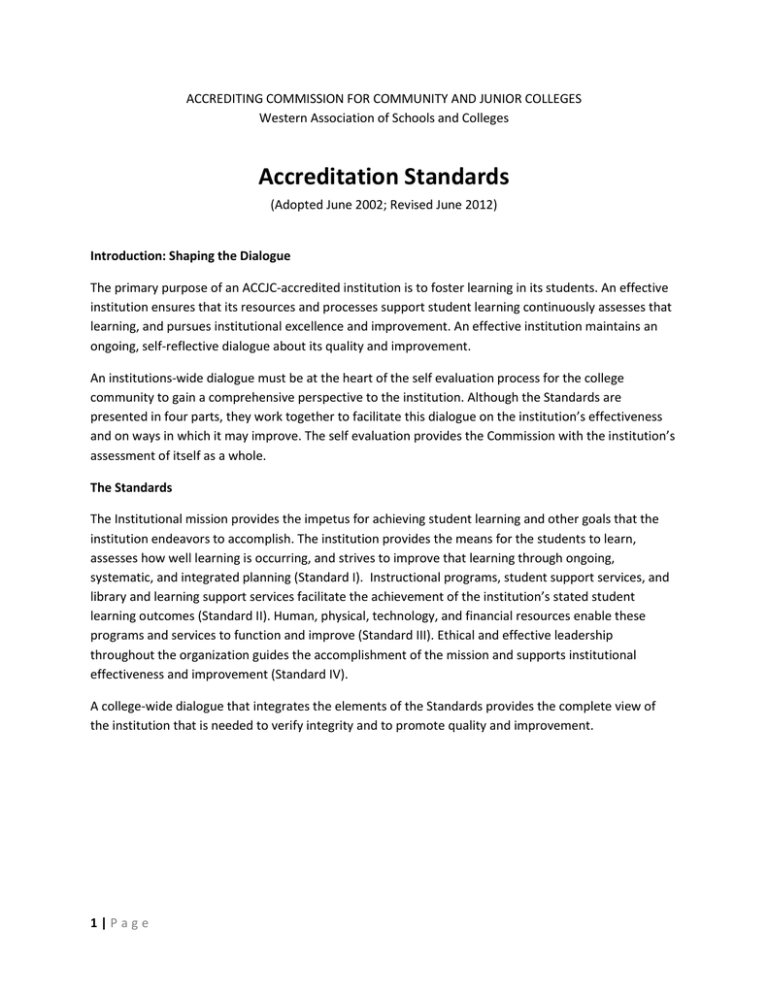
ACCREDITING COMMISSION FOR COMMUNITY AND JUNIOR COLLEGES Western Association of Schools and Colleges Accreditation Standards (Adopted June 2002; Revised June 2012) Introduction: Shaping the Dialogue The primary purpose of an ACCJC-accredited institution is to foster learning in its students. An effective institution ensures that its resources and processes support student learning continuously assesses that learning, and pursues institutional excellence and improvement. An effective institution maintains an ongoing, self-reflective dialogue about its quality and improvement. An institutions-wide dialogue must be at the heart of the self evaluation process for the college community to gain a comprehensive perspective to the institution. Although the Standards are presented in four parts, they work together to facilitate this dialogue on the institution’s effectiveness and on ways in which it may improve. The self evaluation provides the Commission with the institution’s assessment of itself as a whole. The Standards The Institutional mission provides the impetus for achieving student learning and other goals that the institution endeavors to accomplish. The institution provides the means for the students to learn, assesses how well learning is occurring, and strives to improve that learning through ongoing, systematic, and integrated planning (Standard I). Instructional programs, student support services, and library and learning support services facilitate the achievement of the institution’s stated student learning outcomes (Standard II). Human, physical, technology, and financial resources enable these programs and services to function and improve (Standard III). Ethical and effective leadership throughout the organization guides the accomplishment of the mission and supports institutional effectiveness and improvement (Standard IV). A college-wide dialogue that integrates the elements of the Standards provides the complete view of the institution that is needed to verify integrity and to promote quality and improvement. 1|Page Standard I: Institutional Mission and Effectiveness The Institution demonstrates strong commitment to a mission that emphasizes achievement of student learning and to communicating the mission internally and externally. The institution uses analyses of quantitative and qualitative data and analysis in an ongoing and systematic cycle of evaluation, integrated planning, implementation, and re-evaluation to verify and improve the effectiveness by which the mission is accomplished. A. Mission The Institution has a statement of mission that defines the institution’s broad educational purposes, its intended student population, and its commitment to achieving student learning. 1. The institution establishes student learning programs and services aligned with its purposes, its character, and its student populations 2. The mission statement is approved by the governing board and published. 3. Using the institution’s governance and decision making processes, the institutions reviews its mission statement on a regular basis and revises it as necessary. 4. The Institution’s mission is central to institutional planning and decision making. B. Improving Institutional Effectiveness The institution demonstrates a conscious effort to produce and support student learning, measures that learning, assesses how well learning is occurring, and makes changes to improve student learning. The institution also organizes its key processes and allocates its resources to effectively support student learning. The institution demonstrates its effectiveness by providing 1) evidence of achievement of student learning outcomes and 2) evidence of institution and program performance. The institution uses ongoing and systematic evaluation and planning to refine its key processes and improve student learning. 1. The institution maintains an ongoing, collegial, self-reflective dialogue about the continuous improvement of student learning institutional processes. 2. The institutional sets goals to improve its effectiveness consistent with its stated purposes. The institution articulates its goals and states the objectives derived from them in measurable terms so that the degree to which they are achieved can be determined and widely discussed. The institutional members understand these goals and work collaboratively toward their achievement. 3. The institution assesses progress toward achieving its stated goals and makes decisions regarding the improvement of institutional effectiveness in an ongoing and systematic cycle of evaluation, integrated planning, resource allocation, implementation, and re-evaluation. Evaluation is based on analyses both quantitative and qualitative data. 2|Page 4. The institution provides evidence that the planning process is broad-based, offers opportunities for input by appropriate constituencies, allocates necessary resources, and leads to improvement of institutional effectiveness. 5. The institution uses documented assessment results to communicate matters of quality assurance to appropriate constituencies. 6. The institution assures the effectiveness of its ongoing planning and resource allocation processes by systematically reviewing and modifying, as appropriate, all parts of the cycle, including institutional and other research efforts. 7. The institution assesses its evaluation mechanisms through a systematic review of their effectiveness in improving instructional programs, student support services, and library and other learning support services. 3|Page Standard II: Student Learning Programs and Services The institution offers high-quality instructional programs, student support services, and library and learning support services that facilitate and demonstrate the achievement of stated student learning outcomes. The institution provides an environment that supports learning, enhances student understanding and appreciation of diversity, and encourages personal and civic responsibility as well as intellectual, aesthetic, and personal development for all of its students. A. Instructional Programs The institution offers high-quality instructional programs in recognized and emerging fields of study that culminate in identified student outcomes leading to degrees, certificates, employment, or transfer to other higher education institutions or programs consistent with its mission. Instructional programs are systematically assessed in order to assure currency, improve teaching and learning strategies, and achieve stated student learning outcomes. The provisions of this Standard are broadly applicable to all instructional activities offered in the name of the institution. 1. The institution demonstrates that all instructional programs, regardless of location of means of delivery. Address and meet the mission of the institution and uphold its integrity. a. The institution identifies and seeks to meet the varied educational needs of its students through programs consistent with their educational needs of its students though programs consistent with their educational preparation and the diversity, demographics, and economy of its communities. The institution relies upon research and analysis to identify student learning needs and to assess progress toward achieving stated learning outcomes. b. The institution utilizes delivery systems and modes of instruction compatible with the objectives of the curriculum and appropriate to the current and future needs of its students. c. The institution identifies student learning outcomes for courses, programs, certificates, and degrees; assesses student achievement of those outcomes; and uses assessment results to make improvements. 2. The institution assures the quality and improvement of all instructional courses and programs offered in the name of the institution, including collegiate, developmental, and pre-collegiate courses and programs, continuing and community education, study abroad, short-term training courses and programs, programs for international students, and contract or other special programs, regardless of type of credit awarded, delivery mode, or location. a. The institution uses established procedures to design, identify learning outcomes for, approve, administer, deliver, and evaluate courses and programs. The institution recognizes the central role of its faculty for establishing quality and improving instructional courses and programs. 4|Page b. The institution relies on faculty expertise and the assistance of advisory committees when appropriate to identify competency levels and measurable student learning outcomes for courses, certificates, programs including general and vocational education, and degrees. The institution regularly assesses student progress towards achieving those outcomes. c. High-quality instruction and appropriate breadth, depth, rigor, sequencing, time to completion, and synthesis of learning characterize all programs. d. The institution uses delivery modes and teaching methodologies that reflect the diverse needs and learning styles of its students. e. The institution evaluates all courses and programs through an on-going systematic review of their relevance, appropriateness, achievement of learning outcomes, currency, and future needs and plans. f. The institution engages in ongoing, systematic evaluation and integrated planning to assure currency and measure achievement of its stated student learning outcomes for courses, certificates, programs including general and vocational education, and degrees. The institution systematically strives to improve those outcomes and makes the results available to appropriate constituencies. g. If an institution uses departmental course and/or program examinations, it validates their effectiveness in measuring student learning and minimizes test biases. h. The institution awards credit based on student achievement of the course’s stated learning outcomes. Units of credit awarded are consistent with institutional policies that reflect generally accepted norms or equivalencies in higher education. i. The institution awards degrees and certificates based on student achievement of a program’s stated learning outcomes. 3. The institution requires of all academic and vocational degree programs a component of general education based on a carefully considered philosophy that is clearly stated in its catalog. The institution, relying on the expertise of its faculty, determines the appropriateness of each course for inclusion in the general education curriculum by examining the stated learning outcomes for the course. General education has comprehensive learning outcomes for the students who complete it, including the following: a. An understanding of the basic content and methodology of the major areas of knowledge: areas include the humanities and fine arts, the natural sciences, and the social sciences. b. A capability to be a productive individual and life-long learner: skills include oral and written communication, information competency, computer literacy, scientific and quantitative reasoning, critical analysis/logical thinking, and the ability to acquire knowledge through a variety of means. 5|Page c. A recognition of what it means to be an ethical human being and effective citizen: qualities include an appreciation of ethical principles; civility and interpersonal skills; respect for cultural diversity; historical and aesthetic sensitivity; and the willingness to assume civic, political, and social responsibilities locally, nationally, and globally. 4. All degree programs include focused study in at least one area of inquiry or in an established interdisciplinary core. 5. Students completing vocational and occupational certificates and degrees demonstrate technical and professional competencies that meet employment and other applicable standards and are prepared for external licensure and certification. 6. The institution assures that students and prospective students receive clear and accurate information about educational courses and programs and transfer policies. The institution describes its degrees and certificates in terms of their purpose, content, course requirements, and expected student learning outcomes. In every class section students receive a course syllabus that specifies learning outcomes consistent with those in the institutions officially approved course outline. a. The institution makes available to its students clearly stated transfer-of-credit policies in order to facilitate the mobility of students without penalty. In accepting transfer credits to fulfill degree requirements, the institution certifies that the expected learning outcomes for transferred courses are comparable to the learning outcomes of its own courses. Where patterns of student enrollment between institutions are identified, the institution develops articulation agreements as appropriate to its mission. b. When programs are eliminated or program requirements are significantly changed, the institution makes appropriate arrangements so that enrolled students may complete their education in a timely manner with a minimum of disruption. c. The institution represents itself clearly, accurately, and consistently to prospective and current students, the public, and its personnel through its catalogs, statements, and publications, including those presented in electronic formats. It regularly reviews institutional policies, procedures, and publications to assure integrity in all representations about its mission, programs, and services. 7. In order to assure the academic integrity of the teaching-learning process, the institution uses and makes public governing board-adopted policies on academic freedom and responsibility, student academic honesty, and specific institutional beliefs or world views. These policies make clear the institution’s commitment to the free pursuit and dissemination of knowledge. a. Faculty distinguish between personal conviction and professionally accepted views in a discipline. They present data and information fairly and objectively. b. The institution establishes and publishes clear expectations concerning student academic honesty and the consequences for dishonesty. c. Institutions that require conformity to specific codes of conduct of staff, faculty administrators, or students, or that seek to instill specific beliefs or world views, give clear prior notice of such polices, including statements in the catalog and/or appropriate faculty or student handbooks. 6|Page 8. Institutions offering curricula in foreign locations to students other than U.S. nationals operate in conformity with Standards and applicable Commission policies. B. Student Support Services The institution recruits and admits diverse students who are able to benefit from its programs, consistent with its mission. Student support services address the identified needs of students and enhance a supportive learning environment. The entire student pathway through the institutional experience is characterized by a concern for student access, progress, learning, and success. The institution systematically assesses student support services using student learning outcomes, faculty and staff input, and other appropriate measures in order to improve the effectiveness of these services. A. The institution assures the quality of student support services and demonstrates that these services, regardless of location or means of delivery, support student learning and enhance achievement of the mission of the institution.¹ ² B. The institution provides a catalog for its constituencies with precise, accurate, and current information concerning the following: a. General information Official Name, Address(es), Telephone Number(s), and Website Address for the Institution Educational Mission Course, Program, and Degree Offerings Academic Calendar and Program Length Academic Freedom Statement Available Student Financial Aid Available Learning Resources Names and Degrees of Administrators and Faculty Names of Governing Board Members b. Requirements Admissions Student Fees and Other Financial Obligations Degree, Certificates, Graduation and Transfer c. Major Policies Affecting Students Academic Regulations, including Academic Honesty Nondiscrimination Acceptance of Transfer Credits Grievance and Complaint Procedures Sexual Harassment Refund of Fees 7|Page C. a. b. c. d. e. f. d. Locations or Publications Where Other Policies may be found. The institution researches and identifies the learning support needs of its student population and provides appropriate services and programs to address those needs. The institution assures equitable access to all of its students by providing appropriate, comprehensive, and reliable services to students regardless of service location or delivery method. The institution provides an environment that encourages personal and civic responsibility, as well as intellectual, aesthetic, and personal development for all of its students. The institution designs, maintains, and evaluates counseling and/or academic advising programs to support student development and success and prepares faculty and other personnel responsible for the advising function. The institution designs and maintains appropriate programs, practices, and services that support and enhance student understanding and appreciation of diversity. The institution regularly evaluates admissions and placement instruments and practices to validate their effectiveness while minimizing biases. The institution maintains student records permanently, securely, and confidentially, with provision for secure backup of all files, regardless of the form in which those files are maintained. The institution publishes and follows established policies for release of student records. D. The institution evaluates student support services to assure their adequacy in meeting identified student needs. Evaluation of these services provides evidence that they contribute to the achievement of student learning outcomes. The institution uses the results of these evaluations as the basis for improvement. C. Library and learning Support Services Library and other learning support services for students are sufficient to support the institution’s instructional programs and intellectual, aesthetic, and cultural activities whatever format and wherever they are offered. Such services include library services and collections, tutoring, learning centers, computer laboratories, and learning technology development and training. The institution provides access and training to students so that library and other learning support services may be used effectively and efficiently. The institution systematically assesses these services using student learning outcomes, faculty input, and other appropriate measures in order to improve the effectiveness of the services. 1. The institution supports the quality of its instructional programs by providing library and other learning support services that are sufficient in quantity, currency, depth, and variety to facilitate educational offerings, regardless of location or means of delivery. 8|Page a. Relying on appropriate expertise of faculty, including librarians and other learning support services professionals, the institutions selects and maintains educational equipment and materials to support student learning and enhance the achievement of the mission of the institution. b. The institution provides ongoing instruction for users of library and other learning support services so that students are able to develop skills in information competency. c. The institution provides students and personnel responsible for student learning programs and services adequate access to the library and other learning support services, regardless of their location or means of delivery. d. The institution provides effective maintenance and security for its library and other learning support services. e. When the institution relies on or collaborates with other institutions or other source for library and other learning support services for its instructional programs, it documents that formal agreements exist and that such resources and services are adequate for the institution’s intended purposes, are easily accessible, and utilized. The performance of these services is evaluated on a regular basis. The institution takes responsibility for and assures the reliability of all services provided either directly or through contractual arrangement. 2. The institution evaluates library and other learning support services to assure their adequacy in meeting identified student needs. Evaluation of these services provides evidence that they contribute to the achievement of student learning outcomes. The institution uses the results of these evaluations as the basis for improvement. Standard III: Resources The institution effectively uses its human, physical, technology, and financial resources to achieve its broad educational purposes, including stated student learning outcomes, and to improve institutional effectiveness. Accredited colleges in multi-college systems may be organized such that responsibility for resources, allocation of resources and planning rests with the system. In such cases, the system is responsible for meeting standards on behalf of the accredited colleges. A. Human Resources The institution employs qualified personnel to support student learning programs and services wherever offered and by whatever means delivered, and to improve institutional effectiveness. Personnel are treated equitably, are evaluated regularly and systematically, and are provided opportunities for professional development. Consistent with its mission, the institution demonstrates its commitment to the significant educational role played by persons of diverse backgrounds by making positive efforts to encourage such diversity. Human resource planning is integrated with institutional planning. 9|Page 1. The institution assures the integrity and quality of its programs and services by employing personnel who are qualified by appropriate education, training, and experience to provide and support these programs and services. a. Criteria, qualifications, and procedures for selection of personnel are clearly and publicly stated. Job descriptions are directly related to institutional mission and goals and accurately reflect position duties, responsibilities, and authority. Criteria for selection of faculty include knowledge of the subject matter or service to be performed (as determined by individuals with discipline expertise), effective teaching, scholarly activities, and potential to contribute to the mission of the institution. Institutional faculty plays a significant role in selection of new faculty. Degrees held by faculty and administrators are from institutions accredited by recognized U.S. accrediting agencies. Degrees from non-U.S. institutions are recognized only if equivalence has been established. b. The institution assures the effectiveness of its human resources by evaluating all personnel systematically and at stated intervals. The institution establishes written criteria for evaluating all personnel, including performance of assigned duties and participation in institutional responsibilities and other activities appropriate to their expertise. Evaluation processes seek to assess effectiveness of personnel and encourage improvement. Actions taken following evaluations are formal, timely, and documented. c. Faculty and others directly responsible for student progress toward achieving stated student learning outcomes have, as a component of their evaluation, effectiveness in producing those learning outcomes. d. The institution upholds a written code of professional ethics for all of its personnel. 2. The institution maintains a sufficient number of qualified with full-time responsibility to the institution. The institution has a sufficient number of staff and administrator with appropriate preparation and experience to provide the administrative services necessary to support the institution’s mission and purposes. 3. The institution systematically develops personnel policies and procedures that are available for information and review. Such policies and procedures are equitably and consistently administered. a. The institution establishes and adheres to written policies ensuring fairness in all employment procedures. b. The institution makes provision for the security and confidentiality of personnel records. Each employee has access to his/her personnel records in accordance with law. 4. The institution demonstrates through policies and practices an appropriate understanding of and concern for issues of equity and diversity. a. The institution creates and maintains appropriate programs, practices, and services that support its diverse personnel. b. The institution regularly assesses its record in employment equity and diversity consistent with its mission. c. The institution subscribes to, advocates, and demonstrates integrity in the treatment of its administration, faculty, staff and students. 10 | P a g e 5. The institution provides all personnel with appropriate opportunities for continued professional development, consistent with the institutional mission and based on identified teaching and learning needs. a. The institution plans professional development activities to meet the needs of its personnel. b. With the assistance of the participants, the institution systematically evaluates professional development programs and uses the results of these evaluations as the basis for improvement. 6. Human resource planning is integrated with institutional planning. The institution systematically assesses the effective use of human resources and uses the results of evaluation as the basis for improvement. B. Physical Resources Physical resources, which include facilities, equipment, land, and other assets, support student learning programs and services and improve institutional effectiveness. Physical resource planning is integrated with institutional planning. 1. The institution provides safe and sufficient physical resources that support and assure the integrity and quality of its programs and services, regardless of location or means of delivery. a. The institution plans, builds, maintains, and upgrades or replaces its physical resources in a manner that assures effective utilization and the continuing quality necessary to support its programs and services. b. The institution assures that physical resource at all locations where it offers courses, programs, and services are constructed and maintained to assure access, safety, security, and a healthful learning and working environment. 2. To assure the feasibility and effectiveness of physical resources in supporting institutional programs and services, the institution plans and evaluates its facilities and equipment on a regular basis, taking utilization and other relevant data into account. a. Long-range capital plans support institutional improvement goals and reflect projections of the total cost of ownership of new facilities and equipment. b. Physical resource planning is integrated with institutional planning. The institution systematically assesses the effective use of physical resources and uses the results of the evaluations as the basis for improvement. C. Technology Resources Technology resources are used to support student learning programs and services and to improve institutional effectiveness. Technology planning is integrated with institutional planning. 1. The institution assures that any technology support it provides is designed to meet the needs of learning, teaching, college-wide communications, research, and operational systems. 11 | P a g e a. Technology services, professional support, facilities, hardware, and software are designed to enhance the operation and effectiveness of the institution. b. The institution provides quality training in the effective application of its information technology to students and personnel. c. The institution systematically plans, acquires, maintains, and upgrades or replaces technology infrastructure and equipment to meet institutional needs. d. The distribution and utilization of technology resources support the development, maintenance, and enhancement of its programs and services. 2. Technology planning is integrated with institutional planning. The institution systematically assesses the effective use of technology resources and uses the results of evaluation as the basis for improvement. D. Financial Resources Financial resources are sufficient to support student learning programs and services and to improve institutional effectiveness. The distribution of resources supports the development, maintenance, and enhancement of programs and services. The institution plans and manages its financial affairs with integrity and in a manner that ensures financial stability. The level of financial resources provides a reasonable expectation of both short-term and long-term financial solvency. Financial resources planning are integrated with institutional planning at both college and district/system levels in multicollege systems. 1. The institution’s mission and goals are the foundation for financial planning. a. Financial planning is integrated with and supports all institutional planning. b. Institutional planning reflects realistic assessment of financial resource availability, development of financial resources, partnerships, and expenditure requirements. c. When making short-range financial plans, the institution considers its ling-range financial priorities to assure financial stability. The institution clearly identifies, plans, and allocates resources for payment of liabilities and future obligations. d. The institution clearly defines and follows its guidelines and processes for financial planning and budget development, with all constituencies having appropriate opportunities to participate in the development of institutional plans and budgets. 2. To assure the financial integrity of the institution and responsible use of its financial resources, the internal control structure has appropriate control mechanisms and widely disseminates dependable and timely information for sound financial decision making. 12 | P a g e a. Financial documents, including the budget and independent audit, have a high degree of credibility and accuracy, and reflect appropriate allocation and use of financial resources to support student learning programs and services. b. Institutional responses to external audit findings are comprehensive, timely, and communicated appropriately. c. Appropriate financial information is provided throughout the institution in a timely manner. d. All financial resources, including short and long term debt instruments (such as bonds and Certificates of Participation), auxiliary activities, fund-raising efforts, and grants, are used with integrity in a manner consistent with the intended purpose of the funding source. e. The institution’s internal control systems are evaluated and assessed for validity and effectiveness and the results of this assessment are used for improvement. 3. The institution has policies and procedures to ensure sound financial practices and financial stability. a. The institution has sufficient cash flow and reserves to maintain stability, strategies for appropriate risk management, and develops contingency plans to meet financial emergencies and unforeseen occurrences. b. The institution’s internal control systems are evaluated and assessed for validity and effectiveness and the results of this assessment are used for improvement. c. The institution plans for and allocates appropriate resources for the payment of liabilities and future obligations, including Other Post-Employment Benefits (OPEB), compensated absences, and other employee related obligations. d. The actuarial plan to determine Other Post-Employment Benefits (OPEB) is prepared, as required by appropriate accounting standards. e. On an annual basis, the institution assesses and allocates resources for the repayment of any locally incurred debt instruments that can affect the financial condition of the institution f. Institutions monitor and manage student loan default rates, revenue streams, and assets to ensure compliance with federal requirements. g. Contractual agreements with external entities are consistent with the mission and goals of the institution, governed by institutional policies, and contain appropriate provisions to maintain the integrity of the institution. h. The institution regularly evaluates its financial management practices and the results of the evaluation are used to improve internal control structures. 4. Financial resource planning is integrated with institutional planning. The institution systematically assesses the effective use of financial resources and uses the results of the evaluation as the basis for improvement of the institution. Standard IV: Leadership and Governance 13 | P a g e The institution recognizes and utilizes the contributions of leadership throughout the organization for continuous improvement of the institution. Governance roles are designed to facilitate decisions that support student learning programs and services and improve institutional effectiveness, while acknowledging the designated responsibilities of the governing board and the chief administrator A. Decision- Making Roles and Processes The institution recognizes that ethical and effective leadership throughout the organization enables the institution to identify institutional values, set and achieve goals, learn, and improve. 1. Institutional leaders create an environment for empowerment, innovation, and institutional excellence. They encourage staff, faculty, administrators, and students, no matter what their official titles, to take initiative in improving the practices, programs, and services in which they are involved. When ideas for improvement have policy or significant institution-wide implications, systematic participative processes are used to assure effective discussion, planning, and implementation. 2. The institution establishes and implements a written policy providing for faculty, staff, administrator, and student participation in decision-making process. The policy specifies the manner in which individuals bring forward the ideas from their constituencies and work together on appropriate policy, planning, and special-purpose bodies. a. Faculty and administrators have a substantive and clearly defined role in institutional governance and exercise a substantial voice in institutional policies, planning, and budget that relate to their areas of responsibility and expertise. Students and staff also have established mechanisms or organizations for providing input into institutional decisions. b. The institution relies on faculty, its academic senate or other appropriate faculty structures, the curriculum committee, and academic administrators for recommendations about student learning programs and services. 3. Through established governance structures, processes, and practices, the governing board, administrators, faculty, staff, and students work together for the good of the institution. These processes facilitate discussion of ideas and effective communication among the institution. These processes facilitate discussion of ideas and effective communication among the institution’s constituencies. 4. The institution advocates and demonstrates honesty and integrity in its relationships with external agencies. It agrees to comply with accrediting Commission Standards, policies, and guidelines, and commission requirements for public disclosure, self evaluation and other reports, team visits, and prior approval of substantive changes. The institution moves expeditiously respond to recommendations made by the commission. 14 | P a g e 5. The role of leadership and the institution’s governance and decision-making structures and processes are regularly evaluated to assure their integrity and effectiveness. The institution widely communicates the results of these evaluations and uses them as the basis for improvement. B. Board and Administrative Organization In addition to the leadership of individuals constituencies, institutions recognize the designated responsibilities of the governing board for setting policies and of the chief administrator for the effective operation of the institution. Multi-College districts/ systems clearly define the organizational roles of the district/system and the colleges. 1. The institution has a governing board that is responsible for establishing policies to assure the quality integrity, and effectiveness of the student learning programs and services and the financial stability of the institution. The governing board adheres to a clearly defined policy for selecting and evaluating the chief administrator for the college of the district/system. a. The governing board is an independent policy-making body that reflects the public interest in board activities and decisions. Once the board reaches a decision, it acts as whole. It advocates for and defends the institution and protects it from undue influences or pressure. b. The governing board establishes policies consistent with the mission statement to ensure the quality, integrity, and improvement of student learning programs and services and the resources necessary to support them. c. The governing board has ultimate responsibility for educational quality, legal matters, and financial integrity. d. The institution or the governing board publishes the board bylaws and policies specifying the board’s sizes, duties, responsibilities, structure, and operating procedures. e. The governing board acts in a manner consistent with its policies and bylaws. The board regularly evaluates its policies and practices and revises them as necessary f. The governing board has a programs for board development and new member orientation. It has a mechanism for providing for continuity of board membership and staggered terms of office. g. The governing board’s self evaluation processes for assessing board performance are clearly defined. Implemented. And published in its policies or bylaws. h. The governing board has a code of ethics that includes a clearly defined policy for dealing with behavior that violates that code. i. The governing board is informed about and involved in the accreditation process. j. The governing board has the responsibility for selecting and evaluating the district/system chief administrator (most often known as the chancellor) in a multi-college district/system or the college chief administrator (most often known as the president) in the case of a single college. The governing board delegates full responsibility and authority to him/her to implement and administer board 15 | P a g e policies without board interference and holds him/her accountable for the operation of the district/system or college, respectively. In multi-college districts/systems, the governing board establishes a clearly defined policy for selecting and evaluating the presidents of the colleges. 2. The president has primary responsibility for the quality of the institution he/she leads. He/she provides effective leadership in planning, organizing, budgeting, selecting and developing personnel, and assessing institutional effectiveness. a. The president plans, oversees, and evaluates an administrative structure organized and staffed to reflect the institution’s purposes, size, and complexity. He/she delegates authority to administrators and others consistent with their responsibilities, as appropriate. b. The president guides institutional improvement of the teaching and learning environment by the following: Establishing a collegial process that sets values, goals, and priorities; Ensuring that evaluation and planning rely on high quality research and analysis on external and internal conditions; Ensuring that educational planning is integrated with resource planning and distribution to achieve student learning outcomes; and Establishing procedures to evaluate overall institutional planning and implementation efforts. c. The president assures the implementation of statues, regulations, and governing board policies and assures that institutional practices are consistent with institutional mission and policies. d. The president effectively controls budget and expenditures. e. The president works and communicates effectively with the communities served by the institution. 3. In multi-college districts or systems, the district/system provides primary leadership in setting and communicating expectations of educational excellence and integrity throughout the district/system and assures support for the effective operation of the colleges. It establishes clearly defined roles of authority and responsibility between the colleges and the district/system and acts as the liaison between the colleges and the governing board. a. The district/system clearly delineates and communicates the operational responsibilities and functions of the district/system from those of the colleges and consistently adheres to this delineation in practice. b. The district/system provides effective services that support the colleges in their missions and functions. c. The district/system effectively provides fair distribution of resources that are adequate to support the effective operations of the colleges. d. The district/system effectively controls its expenditures. 16 | P a g e e. The chancellor gives full responsibility and authority to the presidents of the colleges to implement and administer delegated district/system policies without his/her interference and holds them accountable for the operation of the colleges. f. The district/system acts as the liaison between the colleges and the governing board. The district/system and the colleges use effective methods of communication, and they exchange information in a timely manner. g. The district/system regularly valuates district/system role delineation and governance and decision-making structures and processes to assure their integrity and effectiveness in assisting the colleges in meeting educational goals. The district/system widely communicates the results of these evaluations and uses them as the basis for improvement. 17 | P a g e List of Policies Referenced in the Standards 1. Policy on Distance Education and on Correspondence Education 2. Policy on Principles of Good Practice in Overseas International Education Programs for Non-U.S. Nationals 3. Policy on Transfer of Credit; Policy on Award of Credit 4. Policy on Closing an Institution. 5. Policy on Institutional Advertising, Student Recruitment, and Representation of Accredited Status. 6. Policy on Contractual Relationships with Non-Regionally Accredited Organizations. 7. Policy and Procedures for the Evaluation of institutions in Multi-College/Multi-Unit Districts or Systems. 18 | P a g e
